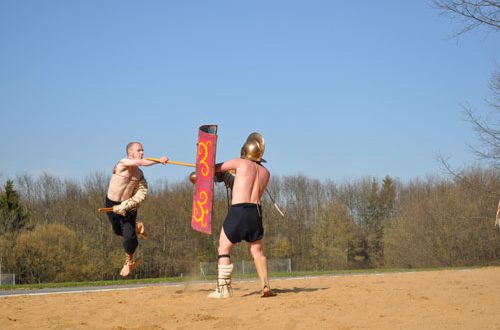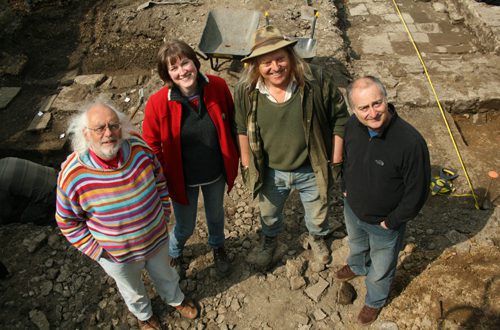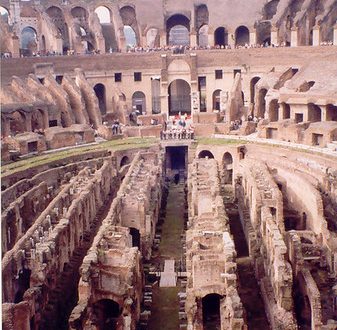 Historians and archaeologists are having to rethink the history of Roman Wales, as the foundations of what is very likely to have been a Roman villa have been discovered at Trawsgoed, about eight miles from Aberystwyth.
Historians and archaeologists are having to rethink the history of Roman Wales, as the foundations of what is very likely to have been a Roman villa have been discovered at Trawsgoed, about eight miles from Aberystwyth.
As many as 21 Roman villas are known in south Wales, but until now archaeologists didn’t believe that the Romans had built villa-sized dwellings as far north as Aberystwyth, in Ceredigion.
In fact, this could be Ceredigion’s first Roman villa, according to the archaeologists working for the Royal Commission on the Ancient and Historical Monuments in Wales (RCAHMW). The realisation was made this summer during the filming of the series Hidden Historiesfor BBC2 Wales.
The First Roman Villa of West Wales?
The discovery is hugely exciting according to archaeologist Toby Driver. He said: After a long hot day in the field we were very surprised to see the buried floor plan of a substantial building on our computer screen. It has all the hallmarks of a classic Roman villa with three main rooms, two projecting wings and a corridor or verandah at the front. We will not know whether or not the building is definitely Roman until we excavate.
The outlines of the probable Roman villa were first seen in aerial photography during a dry summer in 2006 these pictures showed rectangular foundations near Trawsgoed Roman fort, which is now underneath the current Trawsgoed Estate.
Roman Villas in Wales
Toby Driver told Sally Williams in the Western Mail: The building has all the hallmarks of a small Roman villa of a type which flourished from the mid-second to the fourth century AD.
If so, it lies well away from the main block of known Welsh villas in lowland Gwent and the Vale of Glamorgan with a thin spread into south Carmarthenshire and south Pembrokeshire.
However, there are scattered but well-appointed villas occupying the upper Usk Valley and at Llys Brychan near Llangadog in the Tywi Valley, Carmarthenshire.
There are more than 260 sites in the UK where Roman villas are thought to have once stood, according to online-archaeology. The vast majority of these are in central England, with just one, Illogan Roman villa, in Cornwall, and none further north than Middlesbrough. There are nine Roman villas listed in Wales:
- Llantwit Major Roman villa, South Glamorgan
- Moulton Roman villa, South Glamorgan
- Whitton Lodge Roman villa, South Glamorgan
- Croes-Carn-Einion Roman villa, South Glamorgan
- Ely Roman villa, South Glamorgan
- Llys Brychan Roman Villa, Carmarthenshire
- Maesderwen Roman villa, Powys
- Castle Trump Roman villa, Gwent
- Little Hadnock Roman villa (listed as in Hereford and Worster, but according to the map on the Monmouth side of the border).
A further 12 sites in Wales have been identified as containing the remains of possible Roman villas. These are: Castle Tump (Caerwent, Monmouthshire); Dan-y-Graig; Five Lanes Villa, Llanvaches (Caerwerit); Ford Farm Roman Villa; Llandough; Llanbethery; Lower House Farm West (Llantwit Major); Llanmihangael Pen-y-Bryn Farm; New Mill Farm (Monknash); Portskewett; Stoop Hill Roman Villa; Wyndcliff (Porthcasseg).
Roman Villa at Caermead, Llantwit Major
Very little remains of the known Roman villas in Wales. Most are little more than foundations. Caermead villa north of
Llantwit Major, on the south coast, is perhaps the most well-known villa in Wales.
The villa is built around an ‘L’ shaped courtyard and there are several buildings of different sizes for various domestic and agricultural purposes. The villa was discovered in 1888 but it wasn’t excavated fully until 1938-48.
This artist’s impression (from the National Museums & Galleries of Wales) shows what the Roman villa at Caermead may have looked like in the fourth century.
There is evidence of neolithic or Iron Age humans at Llantwit Major, but archaeologists believe that the Roman villa dates from the first century AD, while the foundations of the stone structures were put down during the second century. The villa is notable for its mosaic floors. The villa was abandoned during the fourth century.
The Romans in Wales
 Most of the known Roman remains in Wales are from military camps and forts. There were large legionary bases at Isca Augusta (modern day Caerleon) and across the modern Welsh border at Deva Victrix (Chester). Segontium (Caernarfon) and Moridunum (Carmarthen) were also large military forts. They built roads to access these forts, as well as several mines, such as the Dolaucothi gold mines near Carmarthen.
Most of the known Roman remains in Wales are from military camps and forts. There were large legionary bases at Isca Augusta (modern day Caerleon) and across the modern Welsh border at Deva Victrix (Chester). Segontium (Caernarfon) and Moridunum (Carmarthen) were also large military forts. They built roads to access these forts, as well as several mines, such as the Dolaucothi gold mines near Carmarthen.
Several tribes lived in the area of modern Wales at the time when Romans invaded much of the UK in the first century AD. The main tribes in Wales were the Ordovices in central and north-west Wales, the Silures in the south east, as well as the Deceangli in the north east.
Publius Ostorius Scapula, a governor of Britain under the emperor Claudius, attacked and overcame the Deceangli in 48 AD. He fought against the Silures and the Ordovices, but they put up more resistance, led by the Celtic king Caratacus. The Ordovices were subdued by Ostorius in 51 AD.
The Silures on the other hand, despite attempts by Paulinus to defeat them on Anglesey in 61 AD (he was distracted by Boudica’s revolt), weren’t fully overcome until Sextus Julius Frontinus mounted an attack in 78 AD. Agricola also defeated the Ordovices for a second time in 79 AD and Wales came more or less fully under Roman control.
However, despite the subjugation, it seems that the Romans never fully made themselves at home in Wales. This was mainly through choice the Welsh terrain was deemed too mountainous and inhospitable.
Hidden Histories
The second TV series of Hidden Histories, which follows the archaeological survey work of the RCAHMW, is available on iPlayer (for those within the UK) and a book based on the first series is available from Amazon.
Photos by the Royal Commission on the Ancient and Historical Monuments in Wales.




